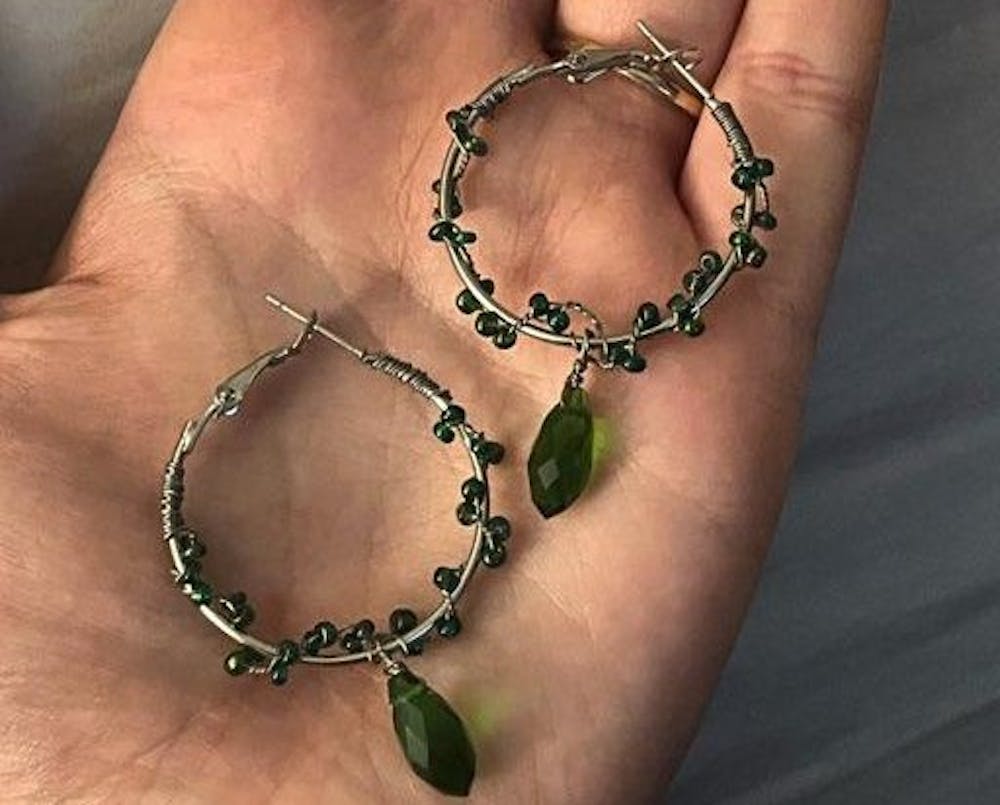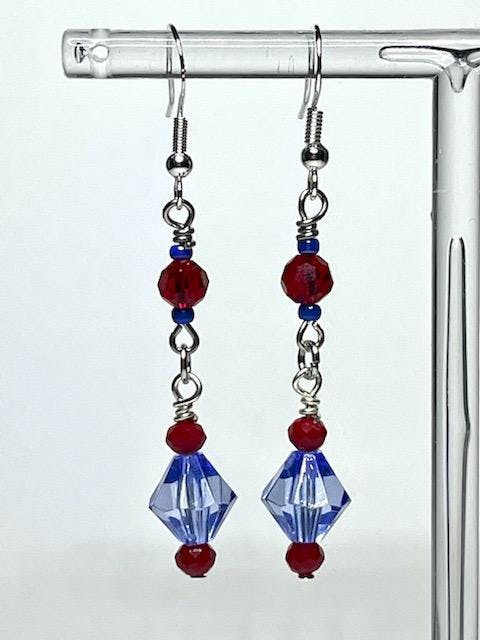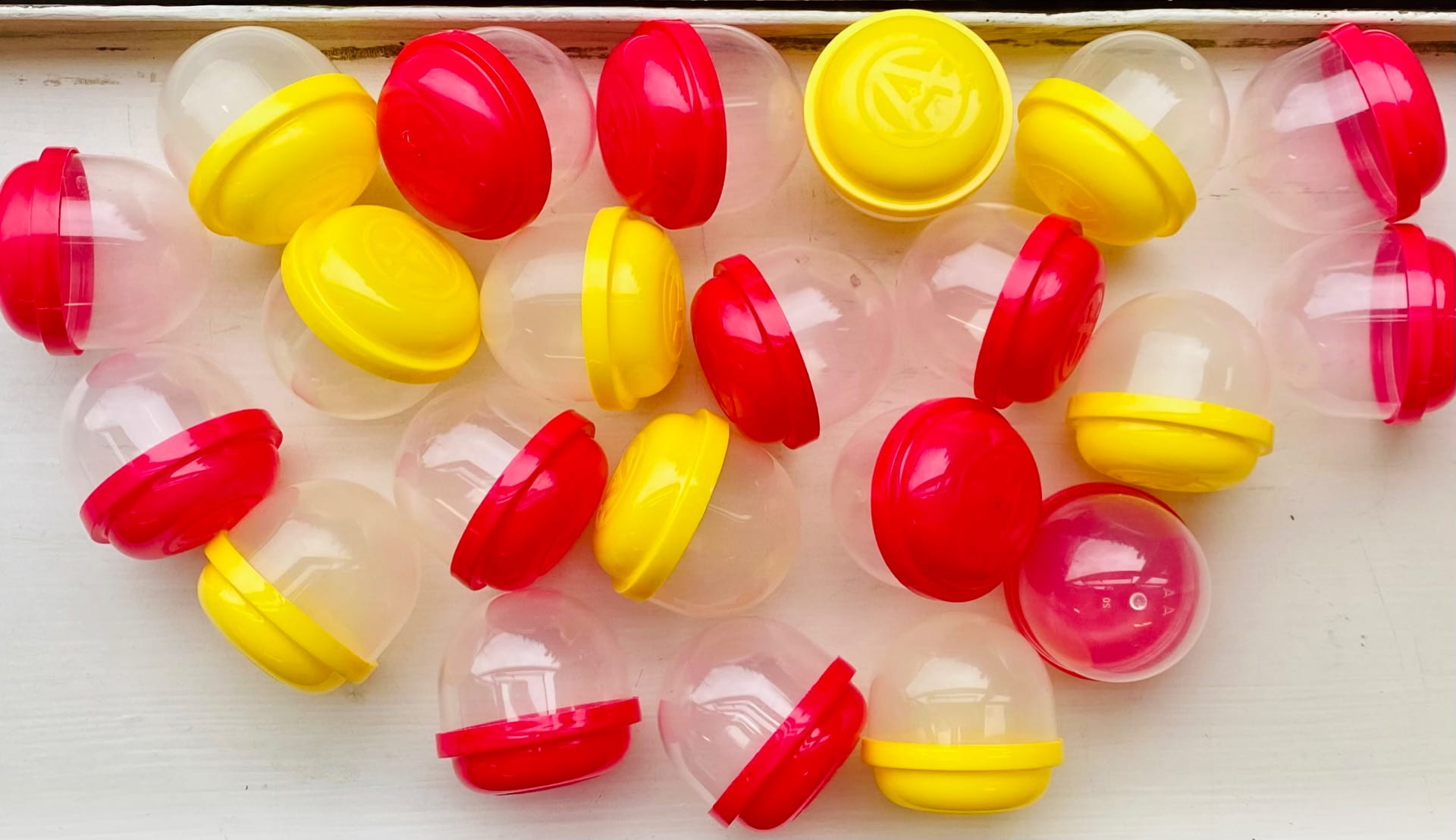
Students turn their creative hobbies into small businesses
As college gets more expensive, student artists have begun selling their work

Green-beaded hoop earrings made by Lila Jensen. She made these in her dorm room at Western Washington University in Bellingham, Wash., on Jan. 16, 2023. // Photo courtesy of Lila Jensen
Amongst the usual dorm items in first-year Western student Lila Jensen’s room are bits of wire, beads and flower charms molded from clay, waiting to be taken home to fire on the next school break.
She slips a necklace and some candy into a packing envelope. She adds the shipping label before beginning the trip to the Viking Union at Western Washington University to ship the package.
Jensen opened her online jewelry shop four years ago. Although she had other forms of income before college, making jewelry became the only thing she could do from her dorm.
Jensen makes all the jewelry by hand. She finds materials anywhere she can, from gifted charms to thrift shop beads.
“I’ll take apart bracelets, necklaces and stuff that are obviously not going to be used anymore or that are falling apart,” Jensen said. “And then I’ll reuse the beads.”
Jensen’s inspiration for starting her jewelry business was her mom, who is a professional jewelry maker, and some leftover clay. Jewelry making is still a passion project despite the business aspects, Jensen said.
“I still think it very much is an outlet and almost, in a way, it feels better because you know that people like what you’re putting out enough to buy it,” Jensen said.
More people are drawn to the idea of running a small business because it allows them the flexibility of being their own boss, said Asche Rider, a business adviser from Western’s Small Business Development Center.
Students who want to open a small business should consider how much time they can put into it.
“With anything in life, where you put your attention and energy is where you’ll see movement,” Rider said. “If someone is genuinely interested in starting a business, be consistent about putting time into it, make it a priority and the results will come faster than they would have otherwise.”

Blue and red beaded earrings made by Lila Jensen. She made these in her dorm room at Western Washington University in Bellingham, Wash., on Feb. 1, 2023. // Photo courtesy of Lila Jensen
Bellingham is home to a thriving local art scene, and many artists attend markets where they can sell their work. One of these is the Whatcom Art Market in Bellingham, Wash.
James Williamson is an artist that has been selling his art at the market since it opened 12 years ago.
Young artists who want to sell their art should focus on the business side just as much as the creative side, Williamson said.
“I’ll sit around and say, ‘Well, tomorrow I’m going to do business stuff,’” Williamson said. “I’m not going to do any art that day because I’m in a different part of my brain. Then I’ll go ‘OK, tomorrow I’m gonna paint.’”
As online markets like Etsy and Depop continue to gain popularity, it’s becoming more and more common for artists to sell their work online. Although these platforms make it easier for artists to get exposure, it also creates new problems.
Depop fees have caused Jensen to increase prices in order to make a profit. She tries to keep costs affordable by offering cheaper prices for customers willing to pick up orders, Jensen said.
“Anything that you sell on is going to be super expensive because they charge the seller,” Jensen said. “They charge you shipping fees, handling fees, packaging fees, printing out shipping label fees. It’s all ridiculous.”
Western’s Art Drop Mini program offers another way for artists to gain exposure for their work. This program sells small art pieces for $1 from gumball machines around campus.
Its goal is to raise money for the art program, but any artist can donate their art.
“We tell people you should put your artist name or your Instagram or whatever platform you use to show your art,” said Rose Nielson, a fourth-year Western student who works with the program. “It gives artists the opportunity to get commissions.”
Finding time for creative pursuits and school can be challenging. You need to ask yourself what is important, said Alicia Gomez, a fourth-year Western student who also works with the program.
“What’s my priorities? What do I need to get done? And just like balancing out your schedule,” Gomez said. “It’s not easy, but it’s worth it.”
Local art for just $1!
Art drop mini gumball machines on WWU campus offer opportunity for accessible art
By Adam Race
Western Washington University students may have noticed the appearance of gumball machines filled with plastic pods on campus. These gumball machines are part of a project from the fine arts department called the “Art Drop Mini,” a collection of machines that dispense small, locally sourced art pieces for just $1.
The project is run and operated by Western fine arts professor Garth Amundson’s professional practices class, a team of students that have worked all quarter on outreach, marketing, planning and filling the machines with art.
The profits of the machines all go toward a scholarship award given to an outstanding Western art student.
Amundson said that, although there has historically been an award given out to an outstanding Western art student, the financial part of it is a new addition, and “there was no money attached to it; it was just a pat on the back, so the students thought that was ridiculous.”
The project started over 20 years ago, first called the B-machine. At that point, it was an old, recycled vending machine, and you could select what you purchased for $3.
“The problem was, how can we get rid of this thing and how can we maintain it, and how can we make affordable small art that art students and non-art students can contribute,” Amundson said.

Amundson revitalized the project with the purchase of two gumball machines in 2017, and his professional practices classes have carried it on since then.
“The premise for this project is: ‘What can you sell? What will anyone buy? How can you facilitate the purchase of a small art project?’” he said.
He said his favorite aspect of overseeing the project is the community spirit and generosity he has witnessed. He said he appreciates everyone’s work and money and is happy that the money goes directly back to the students.
According to the group’s treasurer, Claire Pardue, the group has already raised over $600 between the machines and print sales this quarter, and $100 of that has gone back to the upkeep of the machines. The rest of it is going to the award.
“The scholarship that we give this year will be pretty big, as we raise more throughout the next few quarters from the new locations, it will be a pretty decent chunk of money,” Pardue said.
Amundson also said he is proud of how this class in particular has improved upon the project from previous years.
“Every class has improved on the art drop, now it has constituent branding thanks to the marketing team, and this class has improved every aspect,” he said. “Everyone in this room has collaborated and discussed every aspect of this. There are some real mechanics of the project which have been really fun to watch unfold.”
A box in the main office of the Fine Arts Building acts as a submission bin for pieces and anyone, Western student or not, can add their art to the box and have it used to stock the machines. The group said they are pretty sure every art piece submitted so far has been from Western students. Every member of the group has also submitted at least 30 small works of their own.
Fifth-year student Elise Wooten is a member of the group’s marketing team, as well as a multiple-time contributor to the project.
“A lot of artists struggle with selling their own work and this is us presenting an opportunity for you to get your art out there,” they said. “It gives you a way to put out your art physically and make things physically to put in with very low stakes.”
Wooten is hoping to enter the professional art world after graduation and believes the project has given them great experience in how to run a professional art project.
“The Art Drop Mini has been a really great project for us to do in this class because it’s given us a job and an easier task to see how many components there are to running an art business or being an artist professionally,” they said. “I think we’ve really unified it all. Everyone in the class is very passionate, and everyone in the class works really well together.”
Kelly Sorbel, venue director and facilities manager at Make.Shift Art Space in downtown Bellingham emphasized the importance of accessible art projects like the Art Drop Mini.
“That’s a really good place to start because you are learning how to represent yourself without anybody else representing you,” he said. “It could be a natural progression from that machine to showing at a gallery like [Make.Shift].”
You can support the project at any of the machines on campus or check out the group’s stand in the Viking Union on Nov. 30 during the Art Drop Mini art sale and fundraising event. There, prints from former and current western students will be sold for $5, $10 and $20. All proceeds go toward the scholarship.
https://www.westernfrontonline.com/article/2022/11/art-drop-mini